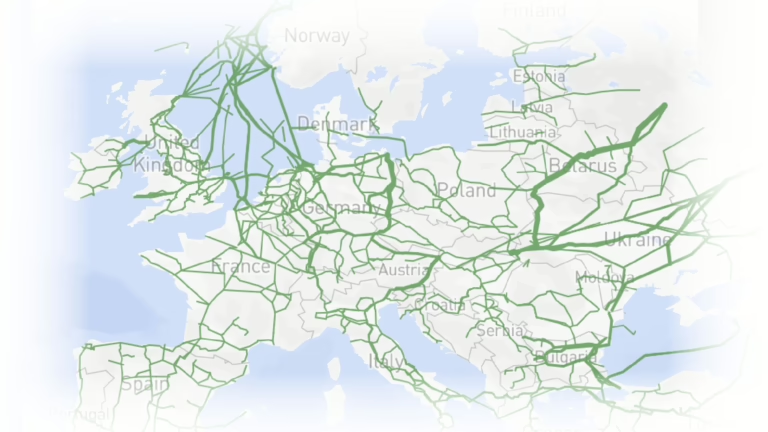Recently, the European Commission announced plans to impose tariffs on Russian oil imports entering the EU via Hungary and Slovakia.
This move follows increased pressure from US President Donald Trump on NATO allies to halt purchases of Russian energy, aiming to weaken Russia’s financial support for its war in Ukraine. Speaking at the UN, Trump criticized the ongoing payments, stating, “They’re funding the war against themselves. Who the hell ever heard of that one?” He was highlighting the fact that EU nations continue to pay over one billion euros ($1.35 billion) monthly to Russia for fossil fuels.
Here, we break down the most recent data on Europe’s oil and gas imports from Russia, explore why certain countries remain dependent on Russian energy, and identify other global buyers of Russian fuel.
Which European countries continue to import Russian energy?
Data from the Centre for Research on Energy and Clean Air (CREA), which monitors actual fossil fuel flows, reveals that in August the EU spent approximately 1.15 billion euros ($1.35 billion) on Russian fossil fuels.
The top five importers made up 85% of this expenditure, purchasing 979 million euros ($1.15 billion) worth of Russian oil and gas. The remaining 15% was distributed among nations such as Spain, Bulgaria, Romania, Italy, Greece, Croatia, Slovenia, Austria, and Poland.
The leading Russian energy importers in Europe are:
- Hungary: 416 million euros ($488 million)
- Slovakia: 275 million euros ($323 million)
- France: 157 million euros ($184 million)
- Netherlands: 65 million euros ($76 million)
- Belgium: 64 million euros ($75 million)
Hungary and Slovakia import Russian crude oil and pipeline gas, whereas France, the Netherlands, and Belgium primarily receive liquefied natural gas (LNG)-natural gas cooled to liquid form for easier maritime transport instead of pipeline delivery.
Europe’s significant dependence on oil and gas
Oil and natural gas together constitute over half of Europe’s energy consumption, with oil accounting for 33% and natural gas 24%. Coal contributes 11.7%, nuclear energy 11.2%, biofuels 10.9%, solar and wind 6.1%, and hydropower 3.1%.
To handle these vast quantities, Europe operates an extensive pipeline network stretching 202,685 kilometers as of 2023, according to GlobalData.
A critical component is the Druzhba pipeline, one of the longest oil pipelines globally, extending 4,000 km (2,500 miles) and capable of transporting between 1.2 and 1.4 million barrels daily. It carries oil from eastern Russia through Belarus and Ukraine to Hungary and Slovakia.
Hungary and Slovakia continue to receive oil via this pipeline under a temporary EU exemption designed to prevent severe energy shortages, as these landlocked nations heavily depend on the Druzhba pipeline and lack alternative import routes or seaports.
How has Europe’s dependence on Russian gas evolved?
Prior to Russia’s invasion of Ukraine in February 2022, the EU imported over 45% of its gas and 27% of its oil from Russia. By 2024, these figures dropped significantly to 19% for gas and just 3% for oil.
European leaders have faced mounting calls to intensify sanctions on Russia to curb energy reliance. However, this transition remains difficult for countries with high dependence on Russian energy sources; for instance, over 60% of Hungary’s energy consumption is derived from oil and gas.
Russian gas imports decreased from more than 150 billion cubic meters (bcm) in 2021 to under 52 bcm in 2024. This gap was largely compensated by increased supplies from other countries: US imports rose from 18.9 bcm to 45.1 bcm, Norway’s deliveries increased from 79.5 bcm to 91.1 bcm, and imports from other partners grew from 41.6 bcm to 45 bcm.
What other Russian commodities does Europe import?
Besides energy, the EU has reduced imports of Russian nickel, iron, and steel.
Conversely, imports of fertilizers-vital for agriculture and a major Russian export-have increased by nearly 20% from 2021 to 2025.
Earlier this year, the European Commission proposed a 6.5% tariff on fertilizer imports from Russia and Belarus, aiming to gradually eliminate dependence on inorganic fertilizers sourced from Moscow.
Who outside the EU is purchasing Russian energy?
In August, China emerged as the largest buyer of Russian fossil fuels, spending 5.7 billion euros ($6.7 billion), with crude oil making up 58% (3.1 billion euros) of these imports.
India followed as the second-largest importer, acquiring 3.6 billion euros ($4.2 billion) worth of Russian energy, 78% (2.9 billion euros) of which was crude oil.
Turkey ranked third, importing 3 billion euros ($3.5 billion) in energy products, including pipeline gas, oil products, crude oil, and coal.
The EU was the fourth-largest purchaser, with imports totaling 1.2 billion euros ($1.4 billion), two-thirds of which were Russian LNG and pipeline gas valued at 773 million euros ($907 million).
South Korea was fifth, importing 564 million euros ($662 million), with coal comprising three-quarters of its Russian energy imports.
























